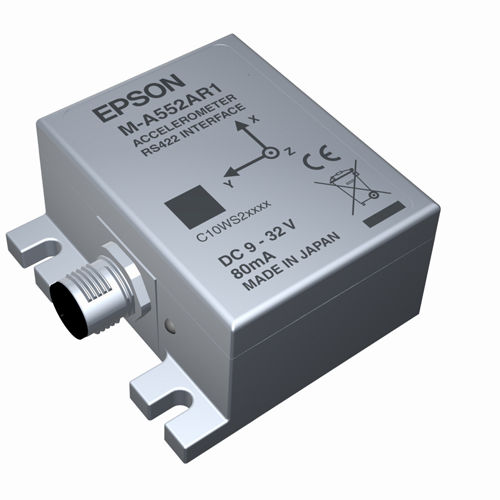Epson presents two new three-axis accelerometers with support for CAN and RS-422 communications

Photo by EPSON EUROPE ELECTRONICS GmbH
Seiko Epson Corporation has added two new high-performance products to its lineup of three-axis accelerometers. The M-A552AC1 supports the CAN communications protocol while the M-A552AR1 supports RS-422. Samples of the new products begins shipping in the summer of 2019, with volume production scheduled for the spring of 2020.
Epson’s accelerometers, first launched in 2014, have been used in an array of applications, earning an excellent reputation for outstanding performance and quality. Aging social infrastructure and the soaring cost of infrastructure maintenance, monitoring, and renewal are recognized as serious social problems for nations and communities. This recognition is driving a growing need for technology to monitor the health of structures using sensors.
In May 2019, Epson began shipping samples of another new accelerometer, the M-A352, to give momentum to the spread of serious structure health monitoring technology. The M-A352 provides the necessary noise performance of 1 µG/√Hz or better (servo accelerometer class) along with outstanding durability and manufacturability, ensuring stable supply and cost competitiveness.
The M-A552AC1 and M-A552AR1 boast the same performance as the M-A352 but come standard equipped with the CAN and RS-422 interfaces, respectively. These interfaces are widely used in industrial applications and demand for them has been strong. They are housed in metal packages that provide IP67-equivalent protection against water and dust.
This high level of protection against the elements enables these products to be used in a wide range of industrial applications that require long distances and excellent stability and reliability.
These products offer the high level of performance required for structure health monitoring and other industrial applications, as well as the flexibility to enable easy system construction. They also make it easy to build multi-node (multi-point) measurement systems, synchronized measurement systems, and other complex, sophisticated measurement systems. Since they are easy to install, connect, and use even outdoors and under other harsh environmental conditions, these accelerometers can sharply reduce customer system development times.
Product features
- High shock resistance: 1,200 G (quadruple that of the products in Epson’s M-A550 series)
- Low noise: 0.5 µG/√Hz typ.
- Wide dynamic range: 27 bits
- Original noise-resistance direct digital conversion technology
For more information, please visit http://www.epson-electronics.de.
News Categories
- » NEWS HOME
- » Automation & Robotics
- » Industry 4.0
- » Material Handling
- » Sensors
- » Quality & Testing
- » Machine Vision
- » Laser & Optics
- » Metalworking
- » Motion Control & Drives
- » Hydraulics & Pneumatics
- » Process Industry
- » Renewable Energy
- » Agriculture
- » Home & Office Furniture
- » Environmental Tech

